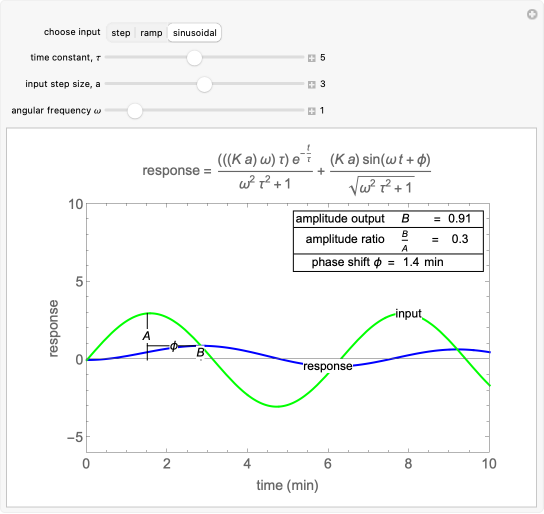First-Order Transfer Functions in Process Control
First-Order Transfer Functions in Process Control
A transfer function is the ratio of the output to the input of a system. The system response is determined from the transfer function and the system input. A Laplace transform converts the input from the time domain to the spatial domain by using Laplace transform relations. The transformed spatial input is multiplied by the transfer function to get the output in the spatial domain. It is then converted back to the time domain using an inverse Laplace transform.
This Demonstration shows the responses to a first-order transfer function. You can vary the magnitude of the input and the time constant . The time constant is related to how long a system takes to reach the new steady state. The input can be a step function, a ramp, or a sinusoidal input.
τ
Details
Details
Step Input and Response
For a step input of magnitude ,
a
s=
t=
x(t)=a
x(s)=
a
s
y(s)=
Ka
s(τs+1)
y(t)=Ka1-
-t
τ
e
τ=0.632ΔSS
ΔSS=
Ramp Input and Response
For a ramp input of magnitude ,
a
x(t)=at
x(s)=
a
2
s
y(s)=
Ka
(τs+1)
2
s
y(t)=Kaτ-1+Kat
-t
τ
e
Sinusoidal Input and Response
ω=2πf
x(t)=asin(ωt)
x(s)=+
(aω)
2
s
2
ω
y(s)=
Kaω
(+1)(+)
τ
s
2
s
2
ω
y(t)=+1++1sin(ωt+ϕ)
Kaωτ
2
ω
2
τ
-t
τ
e
Ka
2
ω
2
τ
ϕ=-(ωt)
-1
tan
time shift
=-p
360
ϕ
amplitude ratio
=
A
B
Permanent Citation
Permanent Citation
Simon M. Lane
"First-Order Transfer Functions in Process Control"
http://demonstrations.wolfram.com/FirstOrderTransferFunctionsInProcessControl/
Wolfram Demonstrations Project
Published: May 6, 2014
